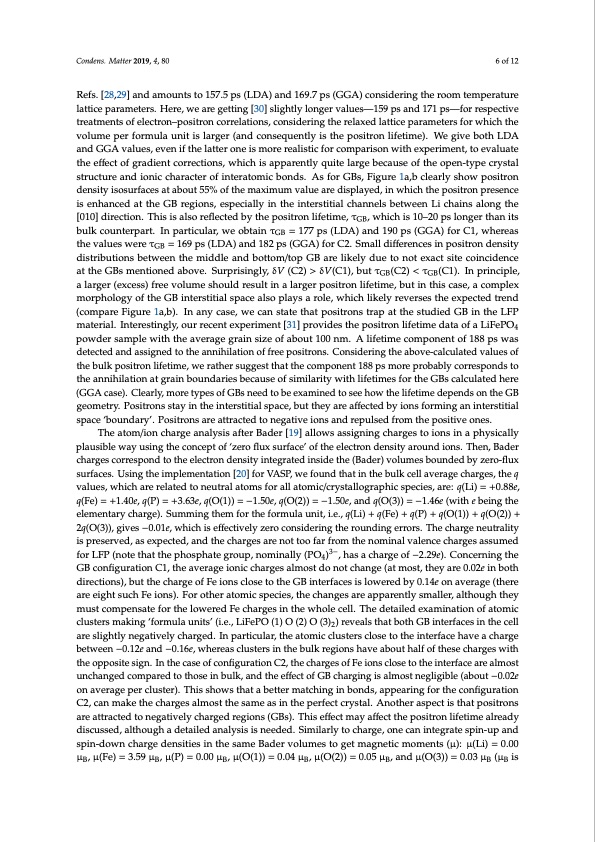
PDF Publication Title:
Text from PDF Page: 006
Condens. Matter 2019, 4, 80 6 of 12 Refs. [28,29] and amounts to 157.5 ps (LDA) and 169.7 ps (GGA) considering the room temperature lattice parameters. Here, we are getting [30] slightly longer values—159 ps and 171 ps—for respective treatments of electron–positron correlations, considering the relaxed lattice parameters for which the volume per formula unit is larger (and consequently is the positron lifetime). We give both LDA and GGA values, even if the latter one is more realistic for comparison with experiment, to evaluate the effect of gradient corrections, which is apparently quite large because of the open-type crystal structure and ionic character of interatomic bonds. As for GBs, Figure 1a,b clearly show positron density isosurfaces at about 55% of the maximum value are displayed, in which the positron presence is enhanced at the GB regions, especially in the interstitial channels between Li chains along the [010] direction. This is also reflected by the positron lifetime, τGB, which is 10–20 ps longer than its bulk counterpart. In particular, we obtain τGB = 177 ps (LDA) and 190 ps (GGA) for C1, whereas the values were τGB = 169 ps (LDA) and 182 ps (GGA) for C2. Small differences in positron density distributions between the middle and bottom/top GB are likely due to not exact site coincidence at the GBs mentioned above. Surprisingly, δV (C2) > δV(C1), but τGB(C2) < τGB(C1). In principle, a larger (excess) free volume should result in a larger positron lifetime, but in this case, a complex morphology of the GB interstitial space also plays a role, which likely reverses the expected trend (compare Figure 1a,b). In any case, we can state that positrons trap at the studied GB in the LFP material. Interestingly, our recent experiment [31] provides the positron lifetime data of a LiFePO4 powder sample with the average grain size of about 100 nm. A lifetime component of 188 ps was detected and assigned to the annihilation of free positrons. Considering the above-calculated values of the bulk positron lifetime, we rather suggest that the component 188 ps more probably corresponds to the annihilation at grain boundaries because of similarity with lifetimes for the GBs calculated here (GGA case). Clearly, more types of GBs need to be examined to see how the lifetime depends on the GB geometry. Positrons stay in the interstitial space, but they are affected by ions forming an interstitial space ‘boundary’. Positrons are attracted to negative ions and repulsed from the positive ones. The atom/ion charge analysis after Bader [19] allows assigning charges to ions in a physically plausible way using the concept of ‘zero flux surface’ of the electron density around ions. Then, Bader charges correspond to the electron density integrated inside the (Bader) volumes bounded by zero-flux surfaces. Using the implementation [20] for VASP, we found that in the bulk cell average charges, the q values, which are related to neutral atoms for all atomic/crystallographic species, are: q(Li) = +0.88e, q(Fe) = +1.40e, q(P) = +3.63e, q(O(1)) = −1.50e, q(O(2)) = −1.50e, and q(O(3)) = −1.46e (with e being the elementary charge). Summing them for the formula unit, i.e., q(Li) + q(Fe) + q(P) + q(O(1)) + q(O(2)) + 2q(O(3)), gives −0.01e, which is effectively zero considering the rounding errors. The charge neutrality is preserved, as expected, and the charges are not too far from the nominal valence charges assumed for LFP (note that the phosphate group, nominally (PO4)3−, has a charge of −2.29e). Concerning the GB configuration C1, the average ionic charges almost do not change (at most, they are 0.02e in both directions), but the charge of Fe ions close to the GB interfaces is lowered by 0.14e on average (there are eight such Fe ions). For other atomic species, the changes are apparently smaller, although they must compensate for the lowered Fe charges in the whole cell. The detailed examination of atomic clusters making ‘formula units’ (i.e., LiFePO (1) O (2) O (3)2) reveals that both GB interfaces in the cell are slightly negatively charged. In particular, the atomic clusters close to the interface have a charge between −0.12e and −0.16e, whereas clusters in the bulk regions have about half of these charges with the opposite sign. In the case of configuration C2, the charges of Fe ions close to the interface are almost unchanged compared to those in bulk, and the effect of GB charging is almost negligible (about −0.02e on average per cluster). This shows that a better matching in bonds, appearing for the configuration C2, can make the charges almost the same as in the perfect crystal. Another aspect is that positrons are attracted to negatively charged regions (GBs). This effect may affect the positron lifetime already discussed, although a detailed analysis is needed. Similarly to charge, one can integrate spin-up and spin-down charge densities in the same Bader volumes to get magnetic moments (μ): μ(Li) = 0.00 μB, μ(Fe) = 3.59 μB, μ(P) = 0.00 μB, μ(O(1)) = 0.04 μB, μ(O(2)) = 0.05 μB, and μ(O(3)) = 0.03 μB (μB isPDF Image | First-Principles Grain Boundary Formation in the Cathode Material LiFePO4

PDF Search Title:
First-Principles Grain Boundary Formation in the Cathode Material LiFePO4Original File Name Searched:
condensedmatter-04-00080.pdfDIY PDF Search: Google It | Yahoo | Bing
Sulfur Deposition on Carbon Nanofibers using Supercritical CO2 Sulfur Deposition on Carbon Nanofibers using Supercritical CO2. Gamma sulfur also known as mother of pearl sulfur and nacreous sulfur... More Info
CO2 Organic Rankine Cycle Experimenter Platform The supercritical CO2 phase change system is both a heat pump and organic rankine cycle which can be used for those purposes and as a supercritical extractor for advanced subcritical and supercritical extraction technology. Uses include producing nanoparticles, precious metal CO2 extraction, lithium battery recycling, and other applications... More Info
| CONTACT TEL: 608-238-6001 Email: greg@infinityturbine.com | RSS | AMP |